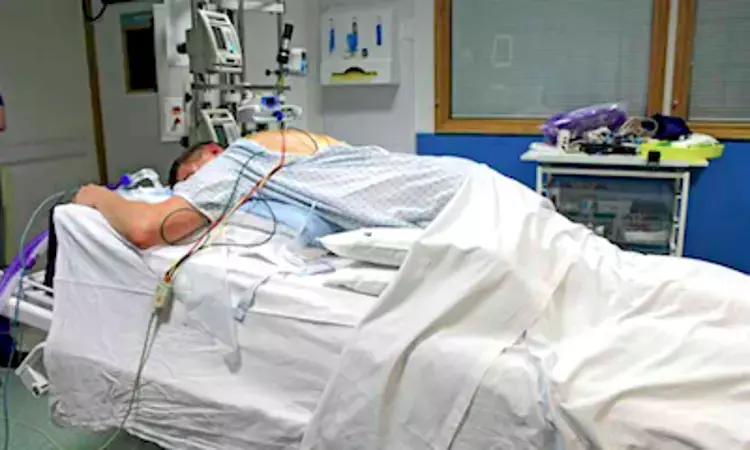- Home
- Medical news & Guidelines
- Anesthesiology
- Cardiology and CTVS
- Critical Care
- Dentistry
- Dermatology
- Diabetes and Endocrinology
- ENT
- Gastroenterology
- Medicine
- Nephrology
- Neurology
- Obstretics-Gynaecology
- Oncology
- Ophthalmology
- Orthopaedics
- Pediatrics-Neonatology
- Psychiatry
- Pulmonology
- Radiology
- Surgery
- Urology
- Laboratory Medicine
- Diet
- Nursing
- Paramedical
- Physiotherapy
- Health news
- Fact Check
- Bone Health Fact Check
- Brain Health Fact Check
- Cancer Related Fact Check
- Child Care Fact Check
- Dental and oral health fact check
- Diabetes and metabolic health fact check
- Diet and Nutrition Fact Check
- Eye and ENT Care Fact Check
- Fitness fact check
- Gut health fact check
- Heart health fact check
- Kidney health fact check
- Medical education fact check
- Men's health fact check
- Respiratory fact check
- Skin and hair care fact check
- Vaccine and Immunization fact check
- Women's health fact check
- AYUSH
- State News
- Andaman and Nicobar Islands
- Andhra Pradesh
- Arunachal Pradesh
- Assam
- Bihar
- Chandigarh
- Chattisgarh
- Dadra and Nagar Haveli
- Daman and Diu
- Delhi
- Goa
- Gujarat
- Haryana
- Himachal Pradesh
- Jammu & Kashmir
- Jharkhand
- Karnataka
- Kerala
- Ladakh
- Lakshadweep
- Madhya Pradesh
- Maharashtra
- Manipur
- Meghalaya
- Mizoram
- Nagaland
- Odisha
- Puducherry
- Punjab
- Rajasthan
- Sikkim
- Tamil Nadu
- Telangana
- Tripura
- Uttar Pradesh
- Uttrakhand
- West Bengal
- Medical Education
- Industry
incidence of retrorenal colon common in prone position for PCNL in children with urolithiasis

Spain: In the lower calyx of the left kidney, the incidence of retrorenal colon (RRC) for an ideal puncture was notably higher in the prone position than in the supine position for percutaneous nephrolithotomy in children, a recent study in the Journal of Pediatric Urology has found. For the right kidney, the RRC occurred only in the prone position.
For treating large and complex stones in children, percutaneous nephrolithotomy is one of the main approaches for the treatment of large and complex stones. Patient position for PCNL has been divided classically into supine or prone and the prone position is used more commonly. Colon injury is one of the most feared complications of this surgical technique.
Against the above background, Esteban Emiliani and the researchers' team from Spain aimed to evaluate the incidence of retrorenal colon in pediatric patients, both in supine and prone positions through radiological images.
For this purpose, the researchers performed a retrospective review of all abdominal CT scans performed in one center. This was done in patients under 18 years from 2017 to 2019. The ideal path for percutaneous puncture was traced in the upper, middle, and lower calyces of both kidneys in the prone and supine positions, and contact with the kidney and adjacent organs were evaluated, with an uro-radiologist.
A retrospective review was performed of all abdominal CT scans performed in one center, on patients under 18 years from 2017 to 2019. The ideal path for percutaneous puncture was traced in the upper, middle, and lower calyces of both kidneys in the prone and supine positions, and an uro-radiologist evaluated the contact with the kidney and adjacent organs. 50 CT scans were performed on 44 children. The mean age of the patients was 12.6 years and 71.4% were male.
The key findings of the study were as follows:
- Twenty-five scans were performed in the prone and 25 in the supine position.
- The incidence of RRC for the left kidney (LK) was significantly higher in the lower calyx in the prone position than in the supine position at 28% vs 4%, and the right kidney (RK) presented RRC only in the prone position.
- The liver was the most frequent retrorenal organ (97.7%) for the RK, with a non-significant difference by position, while for the LK the spleen was the most frequent (61.1%).
"RRC incidence for an ideal puncture was significantly higher in the lower calyx of the left kidney in the prone position compared to the supine position, and in the right kidney, the RRC only occurred in the prone position," the researchers conclude.
Reference:
The study titled, "Retrorenal colon in pediatric patients with urolithiasis: Is the supine position for PCNL advantageous?" was published in the Journal of Pediatric Urology.
DOI: https://doi.org/10.1016/j.jpurol.2022.07.028
Dr Kamal Kant Kohli-MBBS, DTCD- a chest specialist with more than 30 years of practice and a flair for writing clinical articles, Dr Kamal Kant Kohli joined Medical Dialogues as a Chief Editor of Medical News. Besides writing articles, as an editor, he proofreads and verifies all the medical content published on Medical Dialogues including those coming from journals, studies,medical conferences,guidelines etc. Email: drkohli@medicaldialogues.in. Contact no. 011-43720751


